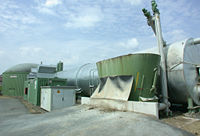
Photo from wikipedia
Hydrogen can be produced through different pathways, i.e., natural gas reforming, gasification of coal, and electrolysis of water. A more sustainable pathway is through bio-H 2 , which can be… Click to show full abstract
Hydrogen can be produced through different pathways, i.e., natural gas reforming, gasification of coal, and electrolysis of water. A more sustainable pathway is through bio-H 2 , which can be produced by bio-photolysis of water and photo-fermentation and dark fermentation of organic matters (OM). However, these routes are still limited by their specific energy requirement, process slowness, and microorganism sensitivity. These limitations can be mitigated by producing bio-H 2 via steam reforming of biogas sources such as landfill or anaerobic digester. In this study, the influence of the methane concentration in the biogas stream on reforming metrics was investigated. Two levels of modeling were pursued here: equilibrium and high fidelity numerical simulations. The former considers several reaction constants, elemental mass conservation, and energy balance. The latter model is based on the reactive Navier-Stokes of non-isothermal and multiple species flow in a cylindrical reactor. Process metrics such as species concentrations and conversion percentages as well as thermal process efficiencies were delineated and evaluated. Results showed that methane concentration has a pronounced influence on the resulting hydrogen concentration and the overall reforming efficiency. The anaerobic CH 4 source resulted in a mole fraction of near 0.3 for H 2 and a reforming efficiency of 36%. These values are much lower than those evaluated for natural gas (mole fraction of 0.5 for H 2 and reforming efficiency of 75%). Although this work illustrates the technical feasibility of biogas reforming, it highlights the low attained process efficiency that can be improved to achieve sustainable bio-H 2 production. Graphical abstract
Journal Title: Biomass Conversion and Biorefinery
Year Published: 2020
Link to full text (if available)
Share on Social Media: Sign Up to like & get
recommendations!